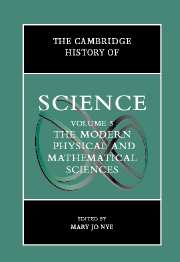Book contents
- Frontmatter
- Introduction: The Modern Physical and Mathematical Sciences
- Part I The Public Cultures of the Physical Sciences After 1800
- Part II Discipline Building in the Sciences: Places, Instruments, Communication
- Part III Chemistry and Physics: Problems Through the Early 1900s
- Part IV Atomic and Molecular Sciences in the Twentieth Century
- 17 Quantum Theory and Atomic Structure, 1900–1927
- 18 Radioactiviy and Nuclerar Physics
- 19 Quantum Field Theory: From QED to the Standard Model
- 20 Chemical Physics and Quantum Chemistry in the Twentieth Century
- 21 Plasmas and Solid-State Science
- 22 Macromolecules: Their Structures and Functions
- Part V Mathematics, Astronomy, and Cosmology Since the Eighteenth Century
- Part VI Problems and Promises at the End of the Twentieth Century
- Index
- References
18 - Radioactiviy and Nuclerar Physics
from Part IV - Atomic and Molecular Sciences in the Twentieth Century
Published online by Cambridge University Press: 28 March 2008
- Frontmatter
- Introduction: The Modern Physical and Mathematical Sciences
- Part I The Public Cultures of the Physical Sciences After 1800
- Part II Discipline Building in the Sciences: Places, Instruments, Communication
- Part III Chemistry and Physics: Problems Through the Early 1900s
- Part IV Atomic and Molecular Sciences in the Twentieth Century
- 17 Quantum Theory and Atomic Structure, 1900–1927
- 18 Radioactiviy and Nuclerar Physics
- 19 Quantum Field Theory: From QED to the Standard Model
- 20 Chemical Physics and Quantum Chemistry in the Twentieth Century
- 21 Plasmas and Solid-State Science
- 22 Macromolecules: Their Structures and Functions
- Part V Mathematics, Astronomy, and Cosmology Since the Eighteenth Century
- Part VI Problems and Promises at the End of the Twentieth Century
- Index
- References
Summary
Few branches of the physical sciences have had more of an impact on the twentieth-century world than radioactivity and nuclear physics. From its origins in the last years of the nineteenth century, the science of radioactivity spawned the discovery of hitherto unsuspected properties of matter and of numerous new elements. Its practitioners charted a novel kind of understanding of the structure and properties of matter, their achievements gradually winning wide acceptance. With its emphasis on the internal electrical structure of matter and its explanation of atomic and molecular properties by subatomic particles and forces, radioactivity transformed both physics and chemistry. Its offspring, nuclear physics and cosmic ray physics, consolidated and extended the reductionist approach to matter, ultimately giving rise to high energy physics, the form of physical inquiry that became characteristic of late-twentieth-century science: large, expensive machines designed to produce ever smaller particles to support ever more complex and comprehensive theories of the fundamental structure of matter.
The significance of nuclear physics extends far beyond the laboratory and even science itself, however. Practiced in only a handful of places in the 1930s, nuclear physics boomed during World War II, when it provided the scientific basis for the development of nuclear weapons. During the Cold War, nuclear and thermonuclear weapons were the key elements in the precarious military standoff between the superpowers. At the same time, the development of the civil nuclear power industry, of nuclear medicine, and of many other applications brought nuclear phenomena to the attention of a large public. Nuclear physicists came to enjoy enormous prestige and to command enormous resources for their science in the context of the nuclear state.
- Type
- Chapter
- Information
- The Cambridge History of Science , pp. 350 - 374Publisher: Cambridge University PressPrint publication year: 2002
References
- 2
- Cited by



